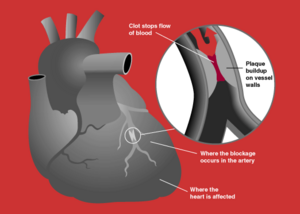Acute coronary syndrome
| Acute coronary syndrome | |
|---|---|
 |
|
| Blockage of a coronary artery | |
| Classification and external resources | |
| Specialty | Cardiology |
| ICD-10 | I24.9 |
| eMedicine | emerg/31 |
| Patient UK | Acute coronary syndrome |
| MeSH | D054058 |
Acute coronary syndrome (ACS) is a syndrome (set of signs and symptoms) due to decreased blood flow in the coronary arteries such that part of the heart muscle is unable to function properly or dies. The most common symptom is chest pain, often radiating to the left arm or angle of the jaw, pressure-like in character, and associated with nausea and sweating. Acute coronary syndrome is usually caused by one of three problems: ST elevation myocardial infarction (STEMI, 30%), non ST elevation myocardial infarction (NSTEMI, 25%), or unstable angina (38%).
These types are named according to the appearance of the electrocardiogram (ECG/EKG) as non-ST segment elevation myocardial infarction and ST segment elevation myocardial infarction. There can be some variation as to which forms of myocardial infarction (MI) are classified under acute coronary syndrome.
ACS should be distinguished from stable angina, which develops during exertion and resolves at rest. In contrast with stable angina, unstable angina occurs suddenly, often at rest or with minimal exertion, or at lesser degrees of exertion than the individual's previous angina ("crescendo angina"). New onset angina is also considered unstable angina, since it suggests a new problem in a coronary artery.
Though ACS is usually associated with coronary thrombosis, it can also be associated with cocaine use. Cardiac chest pain can also be precipitated by anemia, bradycardias (excessively slow heart rate) or tachycardias (excessively fast heart rate).
...
Wikipedia
